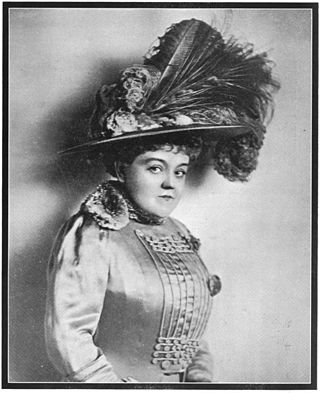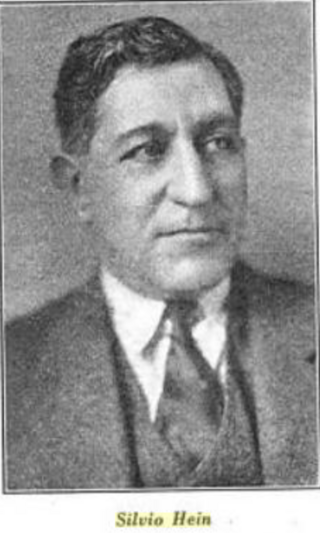Related Research Articles

Jean Schwartz was a Hungarian-born Jewish American composer and pianist. He is best known for his work writing the scores for more than 30 Broadway musicals, and for his creation of more than 1,000 popular songs with the lyricist William Jerome. Schwartz and Jerome also performed together on the vaudeville stage in the United States; sometimes in collaboration with Maude Nugent, Jerome's wife, and the Dolly Sisters. Schwartz was married to Jenny Dolly from 1913 to 1921.

Marie Cahill was a Broadway stage actress and vocalist. Her parents were Irish immigrants Richard and Mary Cahill. She appeared in comic operas including Judy Forgot. She was also in films.

Alfred Hickman was an English actor. He was married to actress Nance O'Neil. He appeared in 35 films between 1914 and 1931.
Tommy Rot is a musical in two acts with both music and lyrics by Safford Waters, and a book by Rupert Hughes, Joseph W. Herbert, Paul West, and Kirke La Shelle. It premiered on Broadway at Mrs. Osborn's Playhouse on October 21, 1902. It ran for 39 performances; closing on November 22, 1902. It used sets by Joseph A. Physioc and D. Frank Dodge.
Louis De Lange, also known as Louis De Lange Moss was an American playwright, actor, and theatrical manager. As a stage actor he primarily appeared in light operas and musicals; notably portraying Sir Joseph Porter in the original production of John Philip Sousa's pirated version of Gilbert and Sullivan's H.M.S. Pinafore in Philadelphia, on Broadway and on tour in 1879. As a dramatist he mainly wrote the books for musicals; often in collaboration with writer Edgar Smith on projects created for the comedy duo Lew Fields and Joe Weber. De Lange also worked as Fields and Weber's manager for their national tours. His wife was the Broadway actress Selma Mantell who appeared in the Ziegfeld Follies among other Broadway shows. Their son was the bandleader and lyricist Eddie DeLange.
Ernest Albert, born Ernest Albert Brown, was an American painter, illustrator, muralist, and scenic designer. He was a prolific scenic designer, first in St. Louis and Chicago and then on Broadway. He is considered a major American landscape painter and was elected the first president of the Allied Artists of America in 1919.
The Billionaire is a musical in three acts with music by Gustave Kerker, and both book and lyrics by Harry B. Smith. The show was written with the backing of producers Klaw and Erlanger and was made specifically for the talents of Jerome Sykes who portrayed "The Billionaire", John Doe. The action of the musical begins in Nice, France during Carnival where the billionaire Sykes meets a young American girl, Pansy Good, studying to be an actress. Impressed with her talents, he buys her Doe's Theatre in New York City and establishes her as a star. Later, Doe attempts to ride a horse in a race at the Longchamp Racecourse in Paris, but is too fat to succeed. Pansy rides the horse instead and wins the race.
Coming Thro' The Rye is a "satiretta" or musical in two acts with both lyrics and book by George V. Hobart and music by A. Baldwin Sloane and J. Sebastian Hiller.
Gates and Morange was a New York City based firm of designers and builders established in 1894 by brothers Frank E. Gates and Richard H. Gates, and the artist Edward A. Morange. The firm had a prolific career as scenic designers for Broadway from the 1890s through the 1930s; creating sets for more than 50 productions. The firm also created designs for trade shows, exhibitions, and businesses. While the organization's work as set designers ended after the mid-1930s, the firm continued to operate in other capacities until it closed in 1953.
Paul West was an American playwright, lyricist, newspaper editor, journalist, screenwriter, author, and talent agent. After working as a journalist in Massachusetts from 1888 to 1892, he began his career in the theatre as a press representative for Charles H. Hoyt; followed by a season as the business manager for the opera singer and actress Camille D'Arville and the comedian Frank Daniels. From 1898 to 1911 he worked on the editorial staff The New York Sunday World during which time be began a career as a prolific lyricist for both Broadway musicals and Tin Pan Alley publishers of popular song; publishing more the 500 songs during his lifetime. He also worked as a playwright, penning both plays and the books for several musicals. More than 15 of his stage works were mounted on Broadway between the years 1902–1913. In 1904 his children's book The Pearl and the Pumpkin was published; a work which he later adapted into a 1905 musical.
Otis C. Sheridan was an American character actor who had a five decade long career on the stage from the 1890s into the early 1940s. He made his Broadway debut in 1901 as Ludwig Dollar in Thomas Q. Seabrooke's revival of the musical The Rounders. He appeared in several more Broadway musicals and plays into the late 1930s, and was also active in regional theatre until his retirement from the stage in 1941. In addition to a career in the theater, he appeared in the films The Night Angel (1931) and Sweet Surrender (1935).

Otho Herbert Dilley, better known by his stage and pen name Herbert Dillea, was an American composer, songwriter, and conductor. He composed the music to three Broadway musicals: The Floor Walkers (1900), The Head Waiters (1902), and My Wife Won't Let Me (1906). As a songwriter, Dilley was best known as the composer to the popular standard "Absence makes the heart grow fonder" ; a work which was recorded multiple times by singer Harry Macdonough and cornetist Jules Levy for records made for the Victor Talking Machine Company and Columbia Records from 1902 through 1905, and later was recorded by Wayne King in 1947. He was also the composer of the ragtime piece Rag time society which was recorded several times by the Metropolitan Orchestra for Victor in 1901 and 1902.
Lifting the Lid is a musical in four scenes with music by Jean Schwartz, lyrics by William Jerome, and a book by John J. McNally. The musical was a spoof of New York City politics of the early 20th century, and included impersonations of both political figures and other personalities of the period. The Manhattan district attorney William Travers Jerome was particularly lampooned as the musical's central character, district attorney William T. G. Rome, was a send up of Jerome and performed in an uncanny impersonation by the actor Julius Tannen.
Fritz in Tammany Hall is a musical in three acts with music by Jean Schwartz, lyrics by William Jerome, and a book by John J. McNally. The musical takes place in 1905 in New York City and on Long Island. It was a political spoof of New York City politics of that period.
Lola from Berlin is a musical in three acts with music by Jean Schwartz, lyrics by William Jerome, and a book by John J. McNally. The musical was created as a starring vehicle for actress Lulu Glaser who portrayed the title role in the original production. The work is about the German girl Lotchen von Breckenhaussett, aka "Lola", who travels from Berlin to New York City to collect an unexpected inheritance from a distant American relation.

The Sleeping Beauty and the Beast is a musical in three acts with music by J. M. Glover and Frederick Solomon and lyrics by J. Cheever Goodwin. Its book by John J. McNally and Goodwin was adapted from the Theatre Royal, Drury Lane's 1900 pantomime of the same name by J. Hickory Wood and Arthur Collins. The musical also included additional music and lyrics by the songwriting team of Jean Schwartz and William Jerome, and by the African-American creative team of Bob Cole, James Weldon Johnson, and J. Rosamond Johnson.

The Defender is a musical in three acts with music by Charles Dennée and both book and lyrics by Allen Lowe. It is best remembered for introducing the popular standard "In the Good Old Summer Time"; a song which was performed in the production by Blanche Ring who made her Broadway debut in this show. Set in Newport, Rhode Island and on the yacht "Hibernia" while at sea, the musical's story focused on the rivalry between an American yachtsman and English yachtsman who are both attempting to win an international yachting competition. Its plot was loosely based on the life of American businessman and yachtsman Thomas W. Lawson.

Nancy Brown is a musical in two acts with music by Henry Kimball Hadley and both book and lyrics by George Broadhurst and Frederic Ranken. The musical also used several songs written by the African-American songwriting team of Robert Cole, J. Rosamond Johnson, and James Weldon Johnson. Set in the royal palace of the fictional kingdom of Ballyhoo, the show was about the matchmaker Nancy Brown's attempt to wed the Ballyhooian royalty and nobility to eight wealthy American heiresses in order to save the financially bankrupt kingdom.

Silvio Hein was an American composer, songwriter, conductor, and theatrical producer. He was a songwriter for Tin Pan Alley and composed the scores to fourteen Broadway musicals. His most successful stage work was the 1917 musical Flo-Flo which he created with the French librettist and playwright Fred de Gresac. His songs were also interpolated into musicals created by others, including The Little Duchess and Ziegfeld Follies. In addition to his work writing music, he also worked as both a conductor and producer on Broadway. In 1914 he was a founding member of the American Society of Composers, Authors and Publishers.

The King's Carnival is a musical burlesque in two acts with music by A. Baldwin Sloane and both book and lyrics by Sydney Rosenfeld. The musical also included one hit song by the songwriting team of Jean Schwartz and William Jerome, "When Mr. Shakespeare Comes to Town". The musical was a parody of several Broadway shows that dealt with royalty and courtly drama, including targeted spoofs of Paul Kester's When Knighthood Was in Flower, Clyde Fitch's The Climbers, Paul M. Potter's Under Two Flags, and Lorimer Stoddard's In the Palace of the King.
References
Bibliography
- Dietz, Dan (2022). "The Wild Rose". The Complete Book of 1900s Broadway Musicals. Rowman & Littlefield Publishers. ISBN 9781538168943.
- Fields, Armond (2009). Eddie Foy: A Biography of the Early Popular Stage Comedian. McFarland & Company. ISBN 9780786443284.
- Mantle, Burns; Sherwood, Garrison P.; Chapman, John Arthur (1944). "The Wild Rose". The Best Plays of 1899-1909. Dodd, Mead & Co.